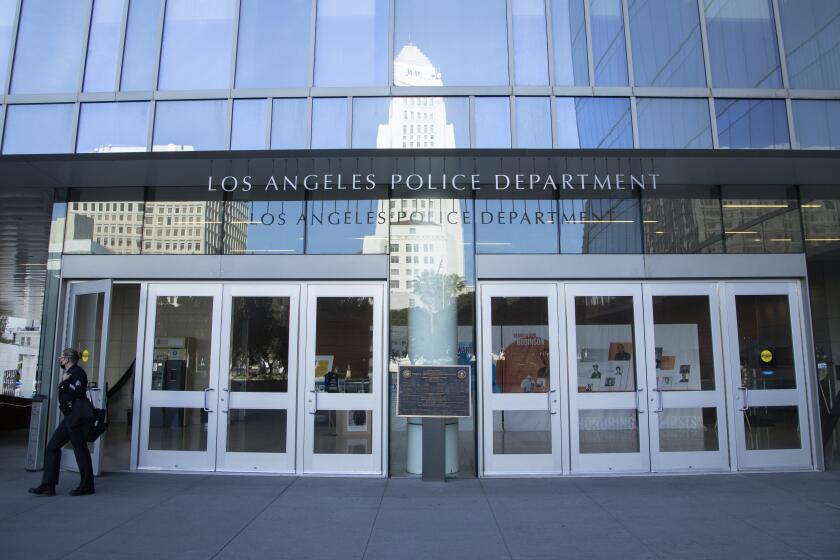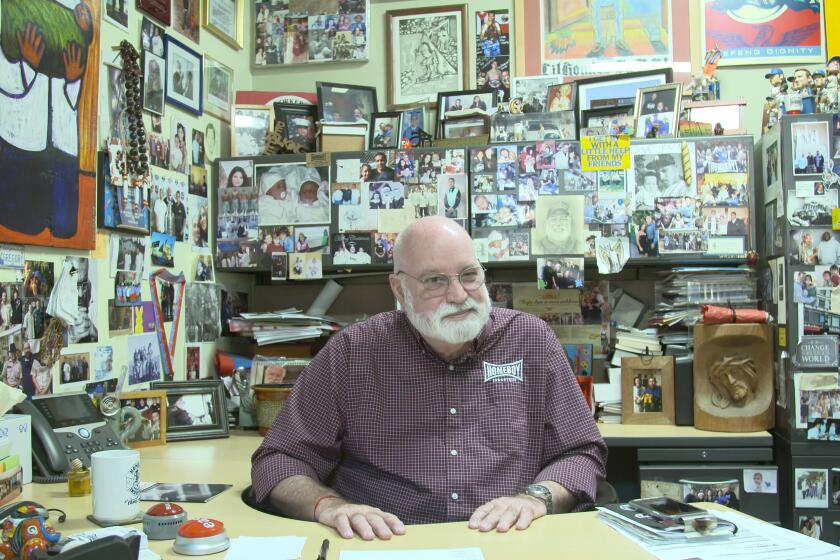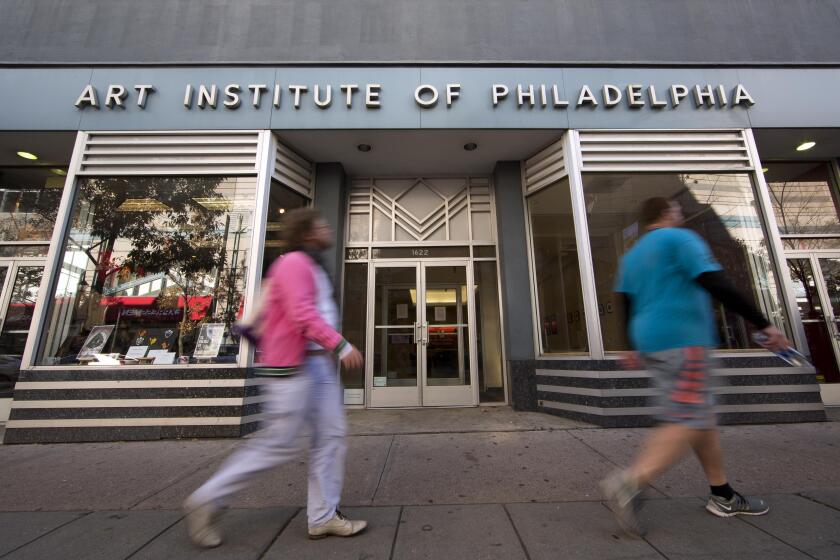New Idea Floated for L.A. River
Damming a stream might seem like a strange way to revive it. But that is the premise behind a proposal to bring back the natural beauty of the Los Angeles River.
The idea, floated by a local artist, has caught the eye of at least one L.A. politician.
City Councilman Ed Reyes, heading a committee that is looking at ways to revitalize the concrete-lined river, says he is intrigued by the idea of installing giant inflatable rubber dams at two ends of downtown. That section would become an artificial lake that could serve as a centerpiece for urban renewal.
It’s nothing more than a dream at this point. But the same thing has been done elsewhere, notably in Arizona, and is increasingly being discussed as a serious possibility for Los Angeles at Reyes’ committee meetings.
Such a project surely would cost millions. But Reyes argues that its value as a recreational asset and magnet for redevelopment would far outweigh the cost.
He envisions the lake as a water gateway of sorts that would unite urban neighborhoods now separated by rail yards and warehouses, enticing boaters to row beneath downtown’s elegant arched bridges while taking in impressive views of the skyline.
Its boundaries, he theorized, could run from the confluence of the Los Angeles River and the Arroyo Seco near Cypress Park to just past downtown’s historic 6th Street bridge
“The river has the potential to be a tool to address some of the problems in this city,” Reyes said. “I am not saying this is a cure-all, but this is a step in the right direction.”
The plan for a rubber dam is welcomed by some Los Angeles River activists, who say they are glad to finally see city leaders thinking bigger about their blighted waterway after decades of neglect. Other activists are wary, saying it reflects a simplistic vision of river revival that they fear could lead to little more than a new tourist trap next to a fake lake.
Though the idea of damming a river to create an artificial lake might sound like the kind of return to natural beauty that only a Los Angeles real estate huckster could conjure up, it was first suggested by a Los Feliz artist, not a downtown land developer.
The artist, Lane Barden, believes his plan would solve the most fundamental problem facing proponents of river restoration: getting the public to see the graffiti-stained concrete channel as a real river. That, he said, is the first step Los Angeles must take if part of the river’s straitjacket is ever to be removed and its natural appearance restored, as many environmentalists hope.
“I see the raising of the dams as a major public event,” Barden said. “Suddenly people would see the river in a different way. Seeing water in the channel will make an enormous difference.”
From an engineering standpoint, similar ideas have already been brought to life.
In Tempe, Ariz., a city of about 160,000 in the Phoenix area that is home to Arizona State University, city leaders have used an intricate system of rubber dams to build their own lakeside district.
The 220-acre Tempe Town Lake was completed in 1999 in the Salt River, a dry desert wash next to the city’s downtown, and it has been a huge success, said city spokeswoman Kris Baxter. It drew 2 million visitors last year who rented boats, fished for freshly stocked trout and took in classical music concerts along its shore.
“We have turned this lake into our community focal point,” Baxter said, adding that the site will have a large rowing regatta next month. “The river bottom was not a pleasant place before. Homeless encampments developed, people would dump stolen cars there. It was a real eyesore, and now it has become something that is really beautiful.”
Tempe Town Lake also serves as a massive flood-control project in an area that had been ravaged by storms, and will allow the city to expand its riverfront development. Plans are underway for a performing arts center and marina. Baxter estimated the city’s overall investment at $100 million, but said the basic improvements needed for the lake cost far less: about $35 million.
The lake is contained by a massive inflatable dam system consisting of four 240-foot, 40-ton rubber tubes on each end, fixed to a concrete base. The dams can be deflated in 45 minutes to prevent flooding in the event of a major rainstorm.
There are 2,200 inflatable dams in use around the world, Tempe officials said, most of them made by Japan’s Bridgestone Corp. In fact, there are already some smaller inflatable dams being used to divert storm water in Los Angeles County, including on the San Gabriel River.
Although damming part of the L.A. River has its advocates, some environmentalists worry that their dreams of restoring the river’s natural state and bringing back native birds and fish could take a back seat to development. The heavily commercial San Antonio River Walk, one of Texas’ top tourist attractions, is another river project being studied by city leaders as a possible model for how to convert the Los Angeles River.
“There are so many other possibilities. I think what Denver has accomplished” on the South Platte River “is a much more interesting example to explore,” said Melanie Winter of the River Project, a Los Angeles environmental group.
Through a series of public and private partnerships, the South Platte River area has been revitalized with a cleanup of the formerly polluted waterway through the city’s downtown and a massive redevelopment program crowned by the construction of Coors Field, the Colorado Rockies’ ballpark.
The LoDo area, as Denver’s lower downtown is now known, is home to art galleries, brew pubs and luxury apartments and is among the city’s trendiest spots. Reyes and other city officials flew Denver officials here last week for a presentation on their river success story.
“It’s a question of priorities,” Winter said. “Any project that the city considers on the Los Angeles River needs to be held up first and foremost to a standard of multiple objectives. We’re trying to improve water quality and water supply, increase habitat and create recreational and economic benefits for communities while maintaining flood protection.”
Though other river restoration advocates share Winter’s concerns, they regard the rubber-dam proposal more favorably.
Landscape architect Nishith Dhandha of Northeast Trees, one of the city’s oldest river groups, likens the scope of the dam plan to the building of Staples Center. But without a similar focus on other goals, such as adding open space to park-starved areas in the city’s center, it would realize only a small part of the river’s potential, he said.
Reyes, who sees a lake as the hub of a new riverfront zone of parks, houses and retail stores, agrees. So does Lewis MacAdams, a poet who co-founded Friends of the Los Angeles River.
“I have always felt it was well worth exploring,” said MacAdams. “It is certainly technologically feasible.”
MacAdams said he has long been interested in Barden’s idea and said that the Cornfield and Taylor Yard, recently acquired by the state to become parks, could be linked by the lake. Visitors also could tour by water the spot where Spanish explorers discovered the Los Angeles River in 1769.
But “no one has begun to really ask all the questions,” MacAdams said.
More to Read
Start your day right
Sign up for Essential California for news, features and recommendations from the L.A. Times and beyond in your inbox six days a week.
You may occasionally receive promotional content from the Los Angeles Times.






